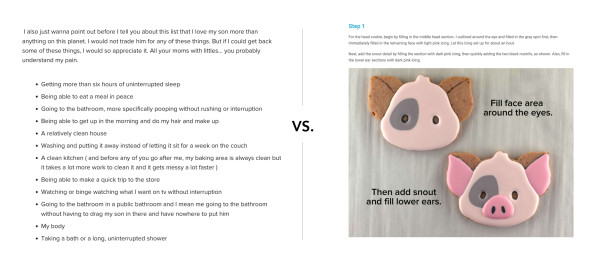How to Write Engaging Content in the Face of AI


There is so much chatter these days about using AI to write copy that I was happy to see Neil Patel touting the importance of interacting with people. After all, is it really possible for a program like ChatGPT to create emotionally engaging copy?
And more importantly, with the plethora of information available at our fingertips, how do you distinguish your voice among the masses?
Let’s look at what we mean by engaging content, and then dive into ways to create content that moves your audience to act.
Will You Be My Blog Reader?
Good content will not only attract, but it will also retain. Crafting original copy, content, or messaging propels your reader, user, or customer into action. And, unless you’ve been living under a rock (please tell me you’re with me on that pun), you know there are ways to measure audience engagement. Measurements such as:
- Clicks and engagement
- Likes and reactions
- Shares and mentions
- Comments and replies
- Profile visits
- Average engagement rate
- Traffic conversions
- Web visitors by channel source
- Social visitors' conversion rate
Marketing is like the cold, cruel world of dating according to Taylor Swift. You know how important it is to attract someone’s attention, but how do you make them stay? How do you get likes, comments, shares, and eventually, brand loyalty?

Are We “Write” For Each Other?
In order to convince the average Internet surfer to stay on your page, you need to write with their intent in mind.
Let’s say you have a website about cookies. I don’t mean that annoying message asking you to accept invisible, mysterious Internet cookies. I mean chocolate chip, peanut butter, macadamia nut, white chocolate chip… you get the idea.
Before I even land on your page I should know whether you:
- Sell cookies.
- Teach people to bake cookies.
- Teach cookie decorating skills.
- Are obsessed with the history of the cookie and have a museum-type website dedicated to all things cookie.
How, you ask, does someone know what you do before they even get to your page?
By optimizing the content on your website so the keywords and phrases on your site align with the intent of the keywords users are searching for in that vertical. More on that later.
In a nutshell (sorry, I just can’t help myself) your content should answer the duality, why should I go to and stay on your site?
Outside the Box
In order to create compelling content, you sit down at your desk and just start clickety-clacking away, right?
Wrong.
Compelling content starts with research — understanding your audience, yes, but also knowing what keywords or phrases your readers are searching for. We’ll address SEO best practices in more detail in a future post, but for now, let’s assume you’ve done your homework and your meta titles and descriptions are well-written using keywords that your customers are searching for and that accurately describe the web page your user is landing on. You also have a solid list of keywords and phrases that hone in on intent, so you’re fairly confident that when someone lands on your page, they’re going to poke around a little and not bounce.
Which means it’s time to get creative.
Back to the cookie website. Let’s say you are a cookie seller. Why should a cookie fanatic buy your cookies? Are they,
- Homemade cookies “nut free” made fresh daily.
- Delicious sugar cookies for any occasion, with custom options available.
- The most awesome chocolate chip cookie you will ever eat. (pssst: Don’t tell Nana!)
Which version did you find most compelling?
Time to Pop the Question
Let’s use a blog as an example for creating engaging content. We’ll change courses a bit and assume you are a home baker who wants to learn how to decorate a cookie so it looks like a work of art.
Without reading ANY of the content and merely judging a blog by its appearance, which blog are you more likely to stay on?

Compelling content does not mean you need to write a term paper or legal brief. When a user lands on a page of all text, chances are they’re not going to read it, no matter how well-written it might be.
It’s just as important to break up your text with other pieces of compelling content.
These tips can be incorporated into blog posts, or for organic social media:
- Ask a question.
- Tell a story.
- Use images or videos.
- Create a chart or infographic.
- Break up text with bulleted lists, images, charts, stats, or white space.
In other words? Show, not tell.
The Wrapping Paper
In school, we were taught to write a conclusion that summarized our main points. In a blog or social media post you want an ending that inspires your audience to act.
- Sign up to receive emails or newsletters.
- Read related articles on your blog.
- Follow on social media.
- Like, comment, and share.
In other words, ask your audience to do something. Anything. If you don’t ask, they won’t act.
And as for AI and ChatGPT, yes, the technology to create content exists, but to make that content drive a connection to humans takes research, variation, a bit of intuition, and most importantly, other humans. Find a voice that will attract, retain, interest, and entertain your readers, and that ultimately makes sense for your brand.
-
Contact Us
-
 Julie JalowiecDirector of Content and EngagementA copywriter at heart, Julie loves to write...but that’s kind of a given. More specifically, she loves writing stories–for clients and for the literary agent who will one day sign her. When she’s not spending time behind her laptop, Julie loves hanging out with her husband and three boys and walking her two rowdy Huskies, Loki and Scarlet.
Julie JalowiecDirector of Content and EngagementA copywriter at heart, Julie loves to write...but that’s kind of a given. More specifically, she loves writing stories–for clients and for the literary agent who will one day sign her. When she’s not spending time behind her laptop, Julie loves hanging out with her husband and three boys and walking her two rowdy Huskies, Loki and Scarlet.